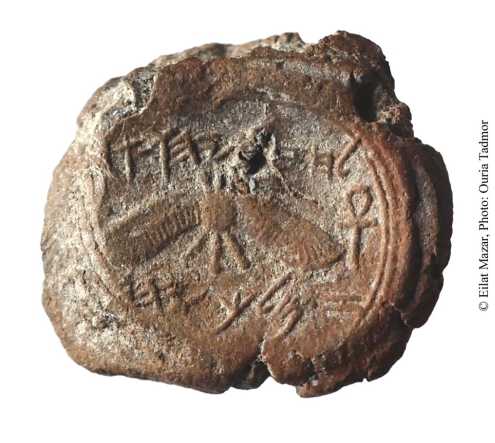Archaeologists in Jerusalem have discovered an impression of the royal seal of King Hezekiah in a refuse dump dated to the reign of the biblical king, or soon after.
The circular inscription, or bulla, measuring 9.7 by 8.6mm, is on a tiny piece of clay excavated from the foot of the southern wall of the Temple Mount in Jerusalem in 2009 by Israeli archaeologists from the Hebrew University of Jerusalem. The piece was stored with 33 other excavated bullae after a first inspection failed to reveal its proper significance.
Dr Eilat Mazar, who directed the excavation that originally uncovered the impression, said in a statement, “this is the first time that a seal impression of an Israelite or Judean king has ever come to light in a scientific archaeological excavation.”
According to scholars at Hebrew University, the inscription reads, “Belonging to Hezekiah [son of] Ahaz king of Judah.” It is believed that small markings on the back of the bulla are imprints of thin cords used to tie papyrus documents together.
King Hezekiah is one of only a few Israelite kings who are praised for their rule: “Hezekiah trusted in the Lord, the God of Israel. There was no one like him among all the kings of Judah, either before him or after him. He held fast to the Lord and did not stop following him; he kept the commands the Lord had given Moses. And the Lord was with him; he was successful in whatever he undertook. He rebelled against the king of Assyria and did not serve him” (2 Kings 18:5-7).
Australian archaeologist Karin Sowada said several such seal impressions or bullae from King Hezekiah’s reign are known about, but what is significant about this one is that it was found in a formal archaeological context.
“This seal fits into an existing group of known seals of King Hezekiah, but a lot of these are known from the antiquities market rather than being found in a controlled archaeological excavation,” said Dr Sowada, a researcher in Egyptian archaeology with Macquarie University in Sydney.
“It’s always good to find an object of a biblical king, and the fact that it has come from a solid archaeological context in Jerusalem does make it more significant than others that are known from the antiquities market which formed the basis of study of these seals for some time.”
Dr Sowada, who is a specialist in the foreign relations of Egypt and the Near East during the Bronze Age, said the new seal impression was from a rare group of bullae with Hezekiah’s name and a winged sun-disk.
While this bulla did not add anything new, it was a good example of the Egyptian iconography used in these seal impressions – a sun disc with six rays and two wings along with the Egyptian hieroglyphic symbol for life.
“There’s quite a lot of debate as to why Egyptian elements have been used,” she said.
“Biblical scholars debate whether Hezekiah was using Egyptian iconography as a political statement, either internally or externally, or whether it was just part of a generalised use of Egpytianised designs which were very much influenced by the Phoenicians and the general influence of the region.”
She commented that Temple Mount’s major archaeologist, Dr Eilat Mazar, has been working for quite a while in what is a controversial area of archaeology in Israel.
“She has found quite a lot of evidence of the early first temple and later periods, and that part of the site is where one would locate the earliest settlement remains in Jerusalem of the Israelite period from the time of David and onwards.”
Email This Story
Why not send this to a friend?
